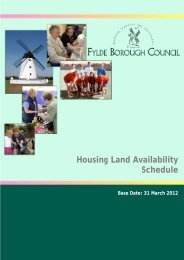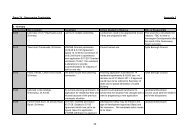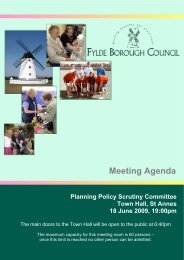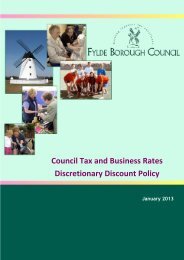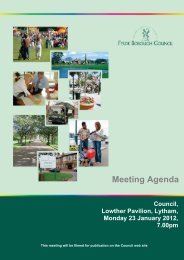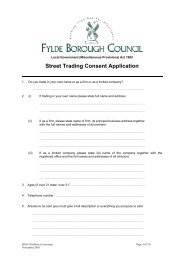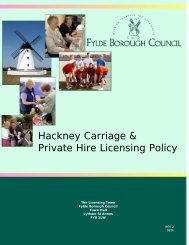Emergency Plan - Fylde Borough Council
Emergency Plan - Fylde Borough Council
Emergency Plan - Fylde Borough Council
Create successful ePaper yourself
Turn your PDF publications into a flip-book with our unique Google optimized e-Paper software.
Tidal – Severe Flood Warning<br />
1. Triggers<br />
<strong>Emergency</strong> <strong>Plan</strong> February 2007<br />
A tidal, surge or strong wind forecast from the Storm Tide Forecasting Service that threshold levels<br />
will be exceeded and flood defences are likely to be overtopped resulting in a major flooding<br />
incident.<br />
Output from tidal forecasting models run by the Environment Agency, tide detection gauges and<br />
observations.<br />
A breach in the tidal defences or failure of a tidal surge barrier and where the impact is likely to be<br />
high.<br />
A Severe Flood Warning may be issued directly (i.e. without the issue of a Flood Watch or Flood<br />
Warning) if warranted by a forecast or observations.<br />
The aim is to issue a Severe Flood Warning to the public at least 2 hours prior to property flooding,<br />
but it is recognised that this is not practicable in all cases.<br />
Consultation will take place with outside organisations (emergency services, local authorities etc) to<br />
ensure trigger levels are set at appropriate levels.<br />
2. Location<br />
For specific Flood Warning Areas or groups of Areas ie named lengths of coast from Point A to B<br />
3. Updates<br />
A Severe Flood Warning Update may be issued at any time when new and relevant information<br />
becomes available.<br />
4.<br />
Downgrades<br />
Severe Flood Warnings will be targeted for specific tides detailing time of high water and location.<br />
When the tide or tides have passed dependant on local conditions, there may be an automatic<br />
downgrade to Flood Watch.<br />
The Flood Watch will be downgraded to All Clear only when forecasts for subsequent tides are<br />
below the relevant thresholds i.e. there is no longer a possibility of flooding.<br />
5. Dissemination<br />
To relevant outside organisations (including local authorities, emergency services, utility companies,<br />
coastguards etc), the media (local radio stations, television text services, Met Offices Weather<br />
Centres, BBC/Independent Weather Productions (IWP) Weather Centres, travel bulletins etc) and<br />
Floodline<br />
To all public recipients via the Floodline Warnings Direct (FWD) which replaces AVM – and includes<br />
warnings via e-mail, SMS, DAB and Digital TV, flood wardens, sirens, loudhailers etc as<br />
appropriate.<br />
Appendix 5<br />
24<br />
Uncontrolled if Printed<br />
Rev.0




